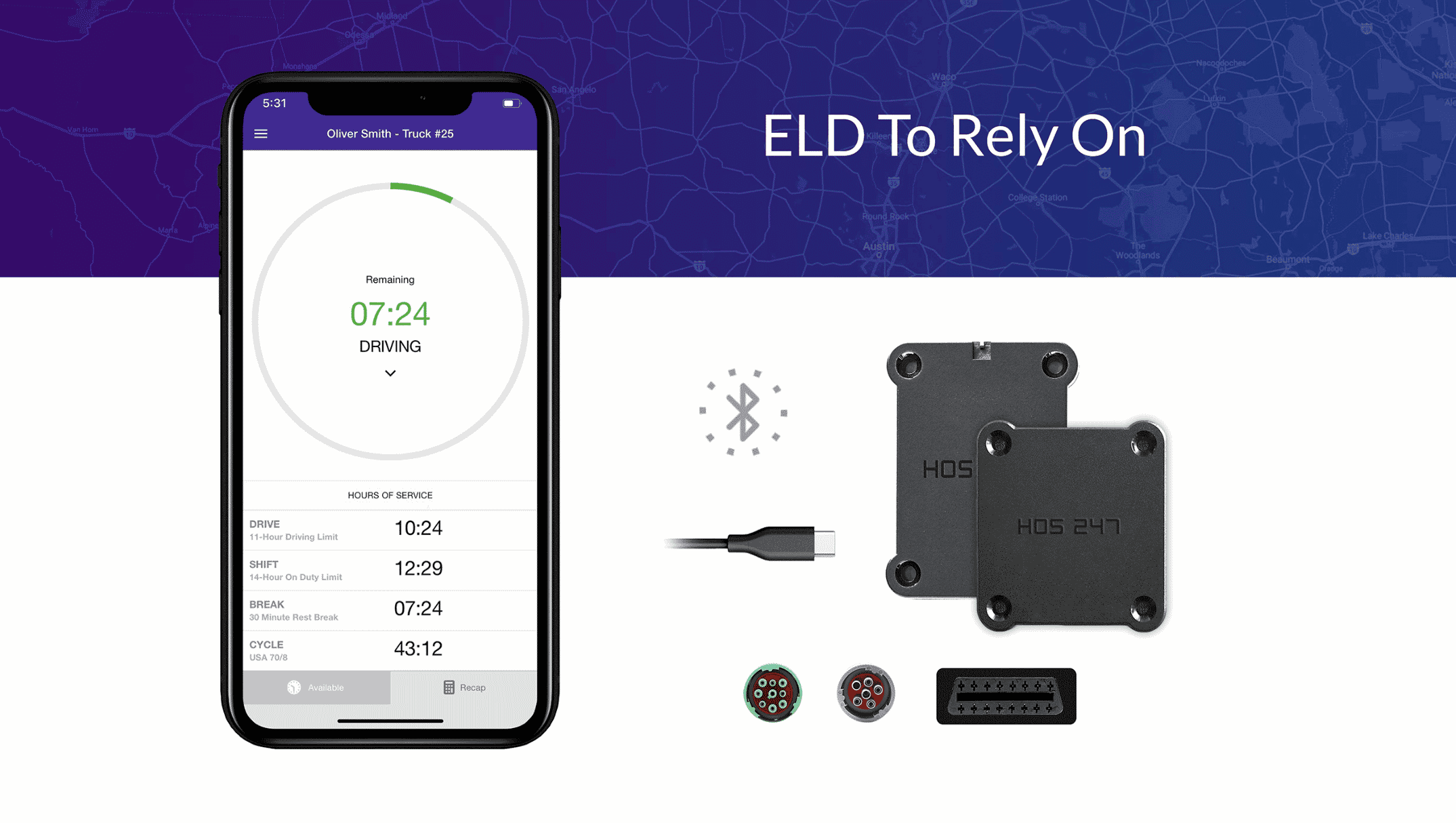Truck drivers must comply with a series of rules and requirements set by the FMCSA. One such requirement is the use of a truck log book to record drivers’ hours of service when operating commercial motor vehicles for interstate trade businesses.
When do I need a truck log book or what size truck needs a log book? Except for some specific exemptions, commercial vehicle drivers must abide by HOS rules if any of the following conditions apply:
- Weight limit. Commercial vehicles that weigh 10,001 lbs or more, or if the gross vehicle or combination weight is equal to or greater 10,001 lbs.
- Type of vehicle. Trucks used for passenger transportation (total of 16 or more persons) or at least 9 paying passengers.
- Type of cargo. Vehicles transporting hazardous materials in amounts large enough to require placards.
Do you have any questions? Talk to ELD Advisor: 650-405-3372 or Request Callback
Differences Between Paper Logs and Electronic Logs
HOS records can be kept on paper or electronically. Broadly speaking, commercial motor vehicles must have an electronic truck log book installed to record drivers’ RODS. Vehicles carrying property and passengers traveling across state lines and drivers domiciled in Mexico or Canada are also included in this rule. Some drivers are exempt from to the use of an electronic logbook, and so paper logs may be used to record their HOS in the following cases:
- Short-haul exception. Applies to drivers operating within a 150 air-mile radius away from their work location.
- RODS under 8 days/month. Drivers who keep RODS for no more than eight days in any given period of 30 days.
- Drive-away-tow-away operations. Meaning that the truck driven is part of or the whole cargo.
- Manufacturing date. Vehicles assembled before the year 2000.
Also, in case of an electronic logbook malfunction, the FMCSA requires drivers to inform their motor carrier and keep their RODS on paper until the device is repaired or replaced.

Electronic Truck Log Books Must Support Updated HOS Rules
HOS rules must be programmed into the elog system to ensure compliance with the maximum on-duty time allowed to drivers. This programming must include rest periods for the drivers in line with the limits established by the authorities, including:
- Drive time 11-hour limit. Drivers may not exceed 11 hours of driving time after 10 hours off-duty.
- On-duty time 14-hour limit. Driving activities may not take place after the 14th hour on-duty. Drivers may not increase this driving time window by increasing off-duty time.
- 30-minute driving break. Drivers must take a 30 minute break after 8 hours of uninterrupted driving time. To satisfy this requirement, any activity other than driving is valid as the 30 minute break.
- Cumulative weekly hours. At the end of a 7/8 day period a driver must not accumulate more than 60/70 hours of on-duty activity. The cumulative on-duty time may be restarted by the driver if they take 34 hours or more of off-duty time.
- Sleeper berth provision. The mandatory 10 hours off-duty per day may be taken as two periods, following these conditions:
- One period is at least 2 hours long.
- One period is at least 7 hours long (assigned as sleeper berth).
- The added time must be at least 10 hours.
Benefits of the HOS247 Logbook
HOS247 provides a truck log book system designed to assist drivers and motor carriers run their operations as efficiently as possible while complying with FMCSA requirements. The HOS247 logbook has some key advantages:
- Compatibility. HOS247 logbook has been tried, tested and shown to operate smoothly on
Android or iOS tablets and smartphones.
- Reliable hardware. A stable connection makes for a fast and accurate collection of engine data, so RODS are always updated.
- User friendly app. Manage logs easily and efficiently to improve HOS compliance.
- Top-rated customer service. A dedicated multilingual team is available to assist truck drivers troubleshoot ELD log issues every day of the week (English, Spanish, Polish, and Russian).
- Flexibility and trial period. HOS247 truck log book plans can be scaled according to the needs of the customer and we have a no-contract policy. Try out the solution for two weeks; if you are not satisfied with the product, you may return it and obtain a hassle-free refund.
- Extra features. Fleet maintenance, vehicle diagnostics, IFTA mileage calculations, among others are available. It also enhances efficiency with a complete and fully integrated real-time GPS tracking, no additional hardware needed.
If you are wondering where to buy truck drivers log book, a semi truck log book or a big truck log book, please click below to see our pricing.
Do you have any questions? Talk to ELD Advisor: 650-405-3372 or Request Callback
Use GPS Tracking For a Complete Solution
GPS technology allows fleet managers to keep track of their fleets in real-time, greatly improving their performance. These systems can be used to manage daily activities easily and efficiently. The HOS247 GPS product offers the following advantages:
-
Real time GPS. Advanced and real-time GPS tracking telematics technology keeps records of the vehicles’ activities and coordinates.
-
Reliable hardware. As per HOS247 standards, easy to install plug-and-play or hardwired tracking devices keep information updated at all times.
-
4GE LTE Technology. A modern 4G/LTE GPS tracking solution ensures a fast and reliable connection.

Instructions to Install the HOS247 Logbook
To set up the HOS247 truck log book, follow these three steps:
STEP 1 – WEB PORTAL SETUP
- Access www.hos247portal.com/ and log in with the provided credentials.
- Click on the “Manage” options, update your Company information, add Vehicles, Portal Users and Drivers.
- According to FMCSA regulations, portal users and drivers must have different login credentials. Portal users cannot log in to the HOS247 app and drivers cannot log into the portal with the same login credentials. Use different emails for portal users and drivers.
STEP 2 – HARDWARE INSTALLATION
- Plug the device into the vehicle port with the 9 pin cable before turning on the vehicle and before running the HOS app. Use adapters if needed. A dual fastener is provided for dash mounting.
- You should see a slow flashing green LED, indicating that the device is powered. You should also see a flashing red LED, indicating that the internal GPS is in acquisition mode. A solid red LED indicates that the signal is locked, but you can proceed to the next step without waiting for the GPS lock.
- Turn the vehicle engine on. You should see a fast flashing green LED, indicating that vehicle bus activity has been detected.
- After the green LED becomes solid, the device is registered on the vehicle bus and you can run the HOS app.
- From this point on, the device will have and retain the information it needs, such as VIN, to communicate with the app via Bluetooth Low Energy. Note that for power management reasons, sometimes the LEDs will not stay on.
STEP 3 – HOS 247 APP SETUP
- Download the HOS 247 app from Google Play or from Apple App Store.
- Make sure the Bluetooth of your tablet/phone is on. DO NOT pair Bluetooth in your phone/tablet settings. The connection will be established in the HOS app. However, if your phone/tablet prompts you or asks you for permission to turn on Bluetooth, you need to do that since Bluetooth is needed for the device to communicate with the app.
- Log in with your credentials (created in Web Portal – please note: according to the FMCSA regulation portal users and drivers must have different login credentials even if this is the same person).
- Select a vehicle from the list of vehicles (created in Web Portal).
- Enter MAC address (listed on the device).
- The Bluetooth indicator at the top right corner of the app means you are ready to start using your HOS247 Logbook.

I’ve co-founded, built and managed several transportation-related businesses. Now, I’m a founder and CEO of HOS247 – an AI Transportation Platform for trucking companies, freight brokers and other logistics operations. We are transitioning old-style operations to technology-advanced logistics entities and help them to grow their businesses. ELDs (electronic logging devices), fleet tracking and management 2.0 combined with AI-powered dispatch tools.












In today’s fast-paced business world, effective asset management is crucial for maintaining a competitive edge. Companies across various industries rely on their assets, such as vehicles, equipment, and inventory, to keep their operations running smoothly. However, managing these assets can

The introduction of the electronic logging device (ELD) mandate has reshaped the transportation industry, ushering in a new era of digital record-keeping. While the mandate has been widely discussed in the context of interstate commercial motor vehicle (CMV) operations, its

For truck owners and carrier companies, logistics is always a priority. This is where real-time tracking of commercial vehicles can offer multiple benefits, including increased productivity and enhanced security. Before going into the advantage of live truck tracking in detail